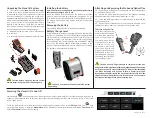
Promag 50/53 W
Hauser
10
Supply voltage
Power consumption
Power supply failure
Lasting minimum 1 power cycle:
•
EEPROM or T-DAT™ (Promag 53 only) retain the measuring-system data in the
event of a power supply failure
•
S-DAT™ = exchangeable data storage chip which stores the data of the sensor:
nominal diameter, serial number, calibration factor, zero point, etc.
Hauser optionally supplies reinforced connecting cables with an additional
metal braid. We recommend such cables for the following cases:
•
Underground laid cables
•
Danger of rodent attack
•
Device used with NEMA 6P (IP 68) ingress protection
Operation in areas of severe electrical interference:
The measuring device complies with the general safety requirements in accordance
with EN 61010, the EMC requirements of EN 61326, and NAMUR recommendation
NE 21.
Caution:
Grounding is by means of the ground terminals provided for that purpose inside the
connection housing. Keep the stripped and twisted lengths of cable shield to the
terminals as short as possible.
85 to 260 VAC, 45 to 65 Hz
20 to 55 VAC, 45 to 65 Hz
16 to 62 V DC
PROFIBUS-PA and FOUNDATION Fieldbus
Nonhazardous: 9 to 32 VDC
Intrinsically safe: 9 to 24 VDC
Explosion proof: 9 to 32 VDC
AC: <15 VA (including sensor)
DC: <15 W (including sensor)
Switch-on current:
•
maximum 13.5 A (< 50 ms) at 24 V DC
•
maximum 3 A (< 5 ms) at 260 V AC
Potential equalization
Standard case
Perfect measurement is only ensured when the medium and the sensor have the
same electrical potential. Most Promag sensors have a standard installed reference
electrode which guarantees the required potential matching. This usually means that
additional potential matching measures are unnecessary.
NOTE: For installation in metal pipes, it is advisable to connect the ground terminal
of the transmitter housing to the piping.
Caution:
For sensors without reference electrodes or without metal process terminals, carry
out potential matching as per the instructions for special cases described below.
These special measures are particularly important when standard grounding
practice cannot be ensured or extremely strong matching currents are expected.











































